MYTHOLOGY
 It had been a dream wedding day, full of joy, spectacle, and much merrymaking. Exhausted from all of the festivities, Leda, the Queen of Sparta, and her new husband, King Tyndareus, were now ready to retire to the royal bedchamber to consummate their union. Which they did. But later that night, while deep in sleep, Leda had a disturbing dream in which she was violated by a magnificent white swan. Little did she know that the swan was actually Zeus, King of the Gods, who had taken the form of the bird in order to….well, let’s not sugarcoat it, what Zeus did was rape Leda.
It had been a dream wedding day, full of joy, spectacle, and much merrymaking. Exhausted from all of the festivities, Leda, the Queen of Sparta, and her new husband, King Tyndareus, were now ready to retire to the royal bedchamber to consummate their union. Which they did. But later that night, while deep in sleep, Leda had a disturbing dream in which she was violated by a magnificent white swan. Little did she know that the swan was actually Zeus, King of the Gods, who had taken the form of the bird in order to….well, let’s not sugarcoat it, what Zeus did was rape Leda.
From the union with her husband, she bore a boy named Kastor (Castor in the Latinized form) and a girl named Helen (she would later become famously known as “Helen of Troy”). From Zeus’s unwanted advances, she bore a boy named Polydeuces (Pollux in the Latinized form) and a girl named Clytemnestra (she would go on to marry Agamemnon, a relationship with tragic consequences).
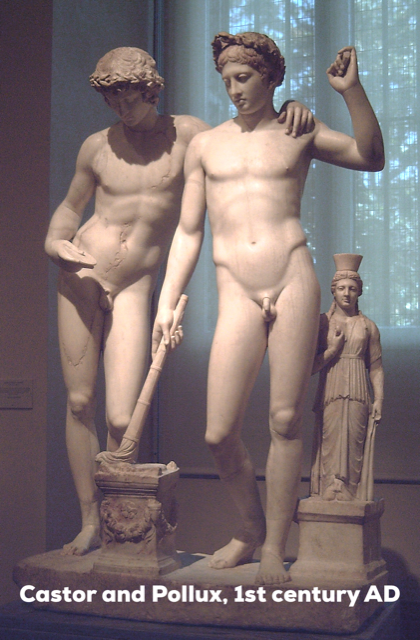
The twin boys (in actuality, half-brothers I suppose), grew to be very close, they looked alike, they dressed alike, were inseparable, and both exhibited remarkable athleticism. Castor excelled at horsemanship and fencing while Pollux became well known for his prowess as a boxer. The two youths joined up with Jason and his Argonauts in their quest for the Golden Fleece. While traveling with Jason, they had many adventures and, on more than one occasion, helped save the crew from a perilous end. So renowned were they for their heroism at sea, they became something like patron saints to sailors.
Years later, they had a run-in with another set of twins, whose girlfriends they absconded with, which resulted in a bloody fight where Castor got run through with a sword. Pollux begged Zeus to allow his immortality (he was the son of a god after all) to be shared with his brother. Taking pity upon them, Zeus granted the wish and placed them in the sky for all eternity as the constellation we know today as “Gemini”. The stars, Castor and Pollux, mark the heads of the twins and are the brightest stars in the constellation.
WHERE TO LOOK
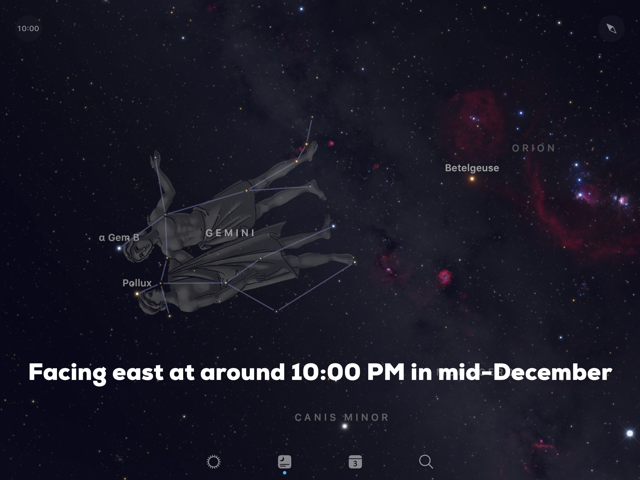
At this time of the year, the constellation of Gemini rises in the east late in the evening but, by month’s end, will have cleared the horizon by 9:00 PM local time. To locate it, just find Orion and look about three fist widths, held out at arm’s length, to the east of the bright star Betelgeuse. Castor and Pollux are the brightest stars in this part of the sky. If you look for it after midnight, you will notice that the twins have moved inexorably across the sky as they head west before setting below the horizon come morning. The two stars are about 5 degrees (half a fist width held out to arm’s length) apart from each other.
WHAT YOU ARE SEEING
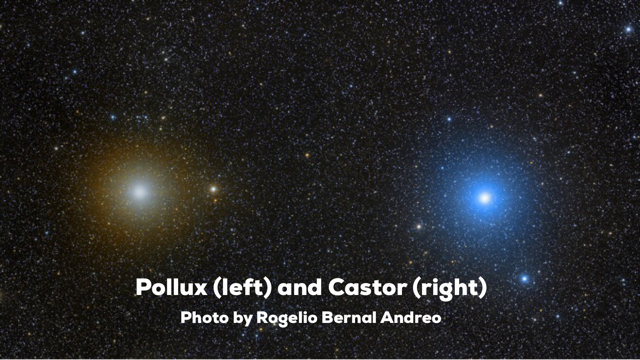 While the myth of Castor and Pollux describes them as being twins, the two stars that represent them are far from being identical. Just a casual glance with the unaided eye tells you that Pollux, the leftmost star (or, the bottom star if you are looking before the constellation has fully risen), is a bit brighter than is Castor. You may also observe that there are color differences between the two. Pollux has a slight yellow-orange hue while Castor is more of a blue-white. This color contrast becomes more noticeable with optical aid. Stars emit colors across a variety of wavelengths, but they will peak at a certain point somewhere along the spectrum. Where they peak tells us something about their temperature. For example, stars that peak more towards the red part of the spectrum are much cooler than those that peak towards the blue end. And color can also help us glean information as to where a star is within its life cycle.
While the myth of Castor and Pollux describes them as being twins, the two stars that represent them are far from being identical. Just a casual glance with the unaided eye tells you that Pollux, the leftmost star (or, the bottom star if you are looking before the constellation has fully risen), is a bit brighter than is Castor. You may also observe that there are color differences between the two. Pollux has a slight yellow-orange hue while Castor is more of a blue-white. This color contrast becomes more noticeable with optical aid. Stars emit colors across a variety of wavelengths, but they will peak at a certain point somewhere along the spectrum. Where they peak tells us something about their temperature. For example, stars that peak more towards the red part of the spectrum are much cooler than those that peak towards the blue end. And color can also help us glean information as to where a star is within its life cycle.
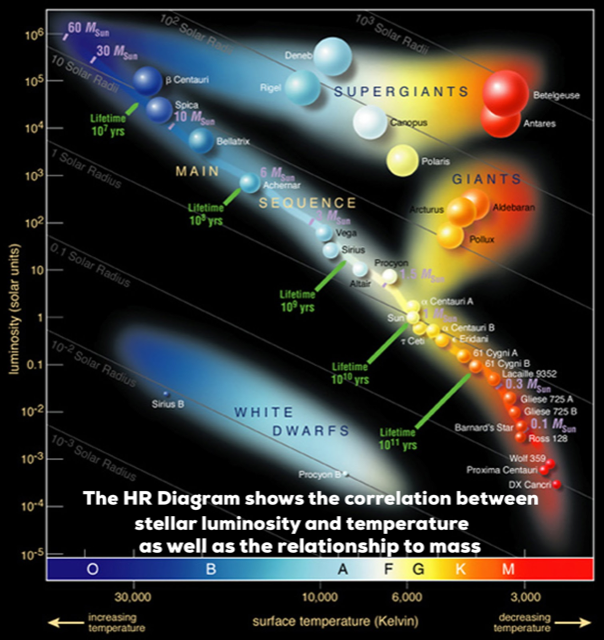 All stars spend the vast majority of their lives in what is known as the “main sequence” phase, where they are steadily fusing the hydrogen fuel supply within their cores. Exactly how long a given star will spend within the main sequence depends upon how massive it is. Small, red dwarf stars are stellar Methuselahs, spending trillions of years within the main sequence, massive, blue-white stars live fast and die young and are within the main sequence for millions of years, while middling stars like the Sun will occupy the main sequence for billions of years. Once they run out of hydrogen within their cores, stars exit the main sequence, swell up into giants, become cooler and redder, and then eventually die. Astronomers use a graphic tool known as the HR Diagram to help them classify stars by plotting their true brightness (luminosity) versus their color (temperatures). At a glance, astronomers (and even you) can then tell something about a star’s spectral type and where it is in its evolutionary stage by using the HR Diagram.
All stars spend the vast majority of their lives in what is known as the “main sequence” phase, where they are steadily fusing the hydrogen fuel supply within their cores. Exactly how long a given star will spend within the main sequence depends upon how massive it is. Small, red dwarf stars are stellar Methuselahs, spending trillions of years within the main sequence, massive, blue-white stars live fast and die young and are within the main sequence for millions of years, while middling stars like the Sun will occupy the main sequence for billions of years. Once they run out of hydrogen within their cores, stars exit the main sequence, swell up into giants, become cooler and redder, and then eventually die. Astronomers use a graphic tool known as the HR Diagram to help them classify stars by plotting their true brightness (luminosity) versus their color (temperatures). At a glance, astronomers (and even you) can then tell something about a star’s spectral type and where it is in its evolutionary stage by using the HR Diagram.
Castor, some 51 light years away, is a relatively hot, massive, young star that it is still on the main sequence while Pollux, located 34 light years away, once a main sequence star but now a cool, orange giant, several times the diameter of the Sun and about 40 times brighter, is nearing the end of its life.
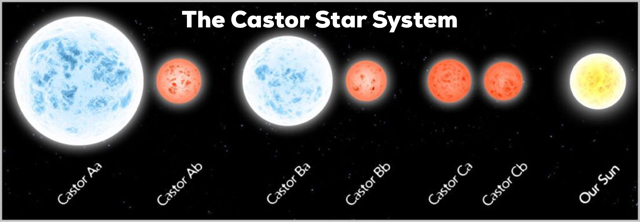 But let’s look at the twins with a small telescope. Particularly at Castor. What you will find is that Castor appears as a double and just to its south, a third component can be seen. But there is even more to Castor than meets your eye at the telescope. Using spectroscopy (the breaking down of a star’s light into its constituent wavelengths), astronomers have been able to determine that Castor is actually a six-star system, all of the components orbiting together around a common center of mass. Just imagine, if you were on a planet orbiting one of these stars, your sky would have six suns. Take that, Luke Skywalker!
But let’s look at the twins with a small telescope. Particularly at Castor. What you will find is that Castor appears as a double and just to its south, a third component can be seen. But there is even more to Castor than meets your eye at the telescope. Using spectroscopy (the breaking down of a star’s light into its constituent wavelengths), astronomers have been able to determine that Castor is actually a six-star system, all of the components orbiting together around a common center of mass. Just imagine, if you were on a planet orbiting one of these stars, your sky would have six suns. Take that, Luke Skywalker!
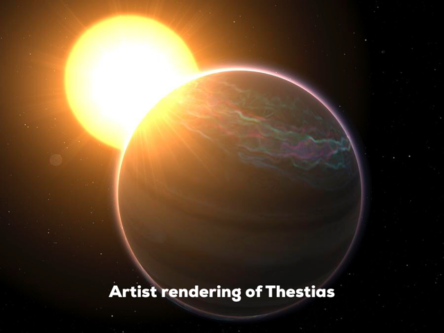 Speaking of planets, we now know that Pollux has an exoplanet orbiting it. Often referred to as Pollux b. This world is a gas giant planet that is 2.3X larger than our own Jupiter (the Roman name for Zeus by the way). Pollux is one of the few bright stars you can easily point to in the sky and then say to your friends, “Hey, there’s a planet orbiting around that star.” In a surprising move, the International Astronomical Union, the governing body in astronomy when it comes to officially naming things like stars and planets, back in 2015 solicited the public to come up with a name for Pollux b. The winning name turned out to be, “Thestias”, the name of Leda’s father in Greek mythology. You might think that it would have been more proper to name it after Leda herself, but that name has already been assigned to one of Jupiter’s 79 moons, all of which are named after the god’s various lovers.
Speaking of planets, we now know that Pollux has an exoplanet orbiting it. Often referred to as Pollux b. This world is a gas giant planet that is 2.3X larger than our own Jupiter (the Roman name for Zeus by the way). Pollux is one of the few bright stars you can easily point to in the sky and then say to your friends, “Hey, there’s a planet orbiting around that star.” In a surprising move, the International Astronomical Union, the governing body in astronomy when it comes to officially naming things like stars and planets, back in 2015 solicited the public to come up with a name for Pollux b. The winning name turned out to be, “Thestias”, the name of Leda’s father in Greek mythology. You might think that it would have been more proper to name it after Leda herself, but that name has already been assigned to one of Jupiter’s 79 moons, all of which are named after the god’s various lovers.
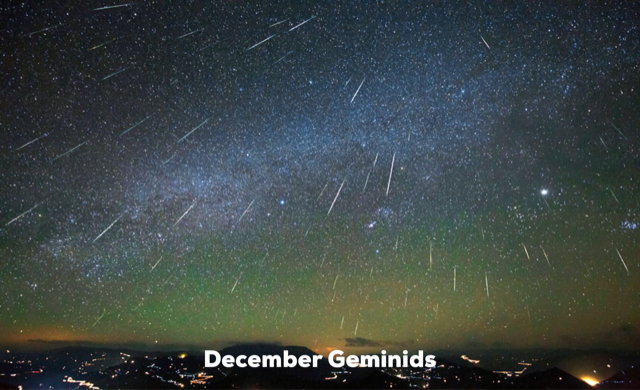 Before I go, you should know that this month’s Geminid Meteor Shower has its radiant located within the constellation. The Geminids is one of the year’s very best meteor showers. Unfortunately, the moon will interfere with the shower this year, drowning out all but a handful of its brightest meteors.
Before I go, you should know that this month’s Geminid Meteor Shower has its radiant located within the constellation. The Geminids is one of the year’s very best meteor showers. Unfortunately, the moon will interfere with the shower this year, drowning out all but a handful of its brightest meteors.